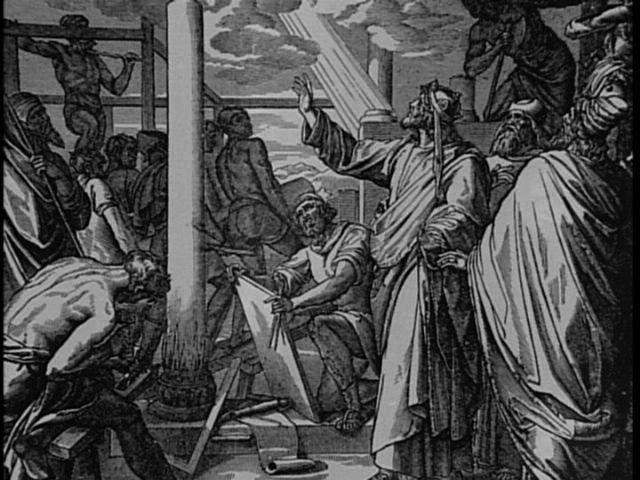
Legendarily, we trace the origins of Freemasonry to the building of King Solomon’s Temple in approximately 950 B.C.E. Historically, Freemasonry evolved from the medieval stonemasons guilds which some believe emerged at the building of the Gothic Cathedral of Strasbourg in France in the year 1275 C.E. While it is unclear when the stonemasons guilds emerged in England and Scotland, the earliest known Masonic text in England is the Regius Poem, also known as The Halliwell Manuscript, possible written around 1390 C.E. (and as late as 1450 C.E.), by a member of the clergy in the West of England. The Regius Poem begins by referring to Euclid and his invention of geometry in ancient Egypt and its spread thereafter. It includes fifteen points for each of the master and mason concerning both moral behavior and the operation of work on a building site.
The most common, early Masonic texts are known as the Old Charges, Old Constitutions or Gothic Constitutions, the earliest known example of which is the Cooke Manuscript. It was likely written around 1425 C.E. About one hundred of these Old Charges survive. Although each is different, they follow a certain sequence. They begin with an invocation, then proceed with a legend of the history of the craft and a list of charges or regulations governing the mason’s conduct, and conclude with an oath or obligation to support those charges. They emphasize morality, the importance of geometry to the mason’s work and King Solomon’s Temple. It would appear that a copy of the Old Charges was read to a man upon his induction into the stonemasons guild and thus was the earliest form of Masonic initiation.
Although the exact date is unclear, sometime around 1600, the stonemasons guilds or lodges of Scotland and England began to admit members who did not actually work for their livelihood as stonemasons. These gentlemen were said to be nonoperative or “speculative” Masons who joined to speculate on, or rather study, the symbolic and theoretical principles of Freemasonry, as opposed to the use of the operative tools and techniques of the stonemasons profession in the building of structures. These nonoperative initiates who joined to learn and study the philosophical side of Masonry became known as “accepted” Masons because they were accepted without the operative skills of the craft. Around the 1630’s, there is evidence that these operative and speculative masons had developed a method by which they could make themselves known to one another. They used a word which you will learn when you are raised a Master Mason. From this beginning, Freemasonry evolved into a philosophical system whereby the stonemasons’ simple tools – – – the square and compass, trowel and plumb, among others – – – were used to teach moral and ethical values.
In 1717, four lodges in London formed the first Grand Lodge. Shortly thereafter, there emerged the three degree system we know and a more formal ritual for the conferral of these three degrees, many portions of which would be recognizable to us today. In essence, the ritual was a mixture of Masonic symbolism and alchemical practices. Our California lectures following each degree conferral can be traced to the work of William Preston in his Illustrations of Masonry, first published in England in 1772, which was the basis of Thomas Smith Webb’s Freemason’s Monitor published in America in 1797.
From these beginnings, Freemasonry has spread around the globe.
